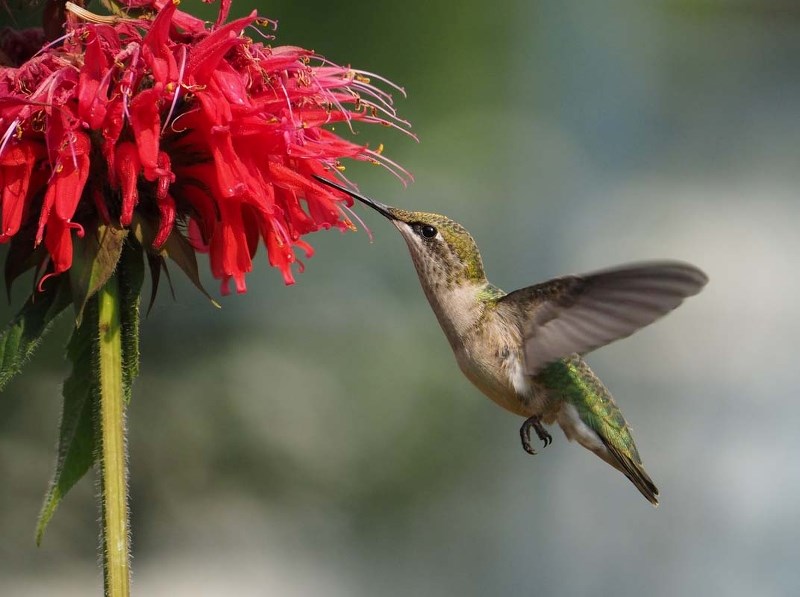I keep getting photobombed by hummingbirds.
Take my boat trip in B.C. last summer, for example. There I was, looking for great blue herons and eagles when this tiny little buzzy-bird starts zipping around the ship. It'd zoom up, down and all around, driving me to distraction as I tried to get a shot of it. It seemed to know it, too, as it actually hovered right above my shoulder when my back was turned at one point.
I'm pretty sure it was sniggering.
Hummingbirds are tiny birds known for the hum produced by their ridiculously fast wings.
The one you're most likely to find here is the ruby-throated hummingbird, says Corey Scobie, assistant curator of ornithology at the Royal Alberta Museum.
"It's going to be the smallest bird you're going to see," he says – so small that you might mistake it for a bee.
The long bill is a giveaway, as is the iridescent green back and white-grey belly. Males of this species will sport a brilliant ruby-red gorget, the colour of which come from light-refracting structures in their feathers, Scobie says – they look black from the side and red head on.
The only other hummingbird we get here is the rufous hummingbird, says Michael Wiens, an Edmonton resident who's written a book on local hummers. Rare in these parts, rufous hummingbirds have a coppery body and a brilliant orange gorget, and sound a bit like a weed-whacker in flight.
Eye-catching speedsters
Like me, Wiens says he's got a fascination with hummingbirds that's hard to control.
"Even after I've seen hundreds of thousands of sightings, it just doesn't get old."
A big part of their appeal is their ludicrous speed and agility. By flapping their wings at about 80 beats a second, these birds can hover in mid-air and fly up, down, side-to-side, backwards and upside-down.
"There's really absolutely no limit to how they can fly," Wiens says.
Ruby-throats average about 65 kilometres an hour in flight, he continues, and can break 100 during steep dives.
"They can escape just about any predator that's after them."
They're also fiercely territorial, he continues, and will aggressively buzz and chase anyone who gets near their favourite food source. He's even seen them take on ravens.
"It doesn't matter what gets in their way, they'll chase it."
Scobie says hummingbirds get this speed from their hyperactive metabolism, one that has them do about 250 breaths and 1,200 heartbeats a minute.
"They need to be feeding almost constantly."
While that usually means nectar or sugar water from a flower or feeder (licked up with their long, curved tongues), it can also mean small insects that they catch on the wing. They also enjoy the sap that oozes from sapsucker holes.
For such a meagre diet, it might come as a surprise to learn that these birds migrate thousands of kilometres each year to and from Central America, making a non-stop 800-kilometre trip across the Gulf of Mexico in the process.
"They lose half their body weight just in that one trip," Wiens notes.
Hummingbird nests are also a wonder to behold. Built from spider webs and fluff, they're often just a few centimetres across, and actually stretch as the baby birds grow up.
"A mother spends basically 55 to 57 minutes out of every hour sitting on the nest," Wiens notes.
That leaves her less than a minute to dash to your yard, guzzle from your flowers, and get back to her eggs.
The Canadian Wildlife Federation recommends planting a variety of plants with different flowering times to give hummingbirds a constant source of nectar. If you use a feeder, clean it every three days to prevent bacterial build-up.
Don't put more than a 25 per cent white sugar solution (a 1:4 sugar-to-water ratio) into your feeder either if you want to see more than one hummingbird, Scobie says. If you go up to 35 per cent, it'll become a super-good food source, and one dominant male will eventually chase off everyone else to monopolize it.
This is actually one of the best times of year to see ruby-throated hummingbirds since we're right in the middle of their southern migration, Wiens says. He had about 60 sightings in a minute earlier this month at his property by Smoky Lake, but wasn't sure how many of those were repeats.
But they'll essentially vanish from here come Labour Day, he adds.
A ruby-throat got in one last photobomb on me last weekend while I was shooting a Cooper's hawk in Parkwood. I was zoomed in and focused on the majestic predator some two stories up in a tree when zip! A tiny, feathered helicopter zipped up to it, checked it out, and then zoomed away, leaving both man and hawk thoroughly confused.
I swear it did that on purpose.
Ruby-throated hummingbird
Name:
Archilochus colubris.
Appearance:
Tiny bird with shiny metallic green back, greyish-white belly, forked tail and a long beak. Males will have a brilliant ruby-red gorget. Wings produce audible buzz in motion.
Commonly seen:
Zipping around flowers and feeders, especially red and orange ones.
Occasionally confused with:
Rufous hummingbirds, which are copper-coloured and have orange gorgets, and bees.
Fun fact:
Hummingbirds enter a coma-like torpor when they sleep, one so total that they seem dead. They can even sleep upside down in this state.
Wild St. Albert
Wild St. Albert<br />Wild St. Albert is going on vacation as of this week since I've run out of animals to profile. Special thanks to all the local and international naturalists who have contributed over the last two years. <br />Watch for the new Scientific St. Albert column later this fall.




